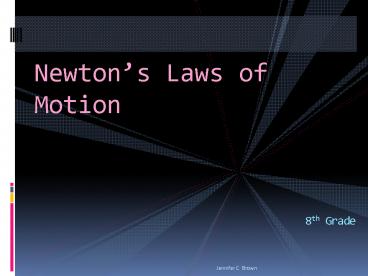Newton - PowerPoint PPT Presentation
1 / 15
Title:
Newton
Description:
Newton s Laws of Motion 8th Grade Jennifer C. Brown 5.3 - Forces and Equilibrium ~Background info~ The sum of all the forces acting on an object is called the ... – PowerPoint PPT presentation
Number of Views:102
Avg rating:3.0/5.0
Title: Newton
1
8th Grade
- Newtons Laws of Motion
2
5.3 - Forces and EquilibriumBackground info
- The sum of all the forces acting on an object is
called the net force (or total force).
3
5.3 - Forces and Equilibrium
- To figure out if or how an object will move, we
look at ALL of the forces acting on it.
4
5.3 - Forces and Equilibrium
- When several forces act on the same object
- 1. The net force is zero
- Or
- 2. The net force is NOT zero.
5
5.3 - Forces and Equilibrium
- When the forces are balanced, the net force is
zero. - When the net force on an object is zero, we say
the object is in equilibrium.
6
5.3 - Forces and Equilibrium
- What is a normal force?
- A normal force is created whenever an object is
in contact with a surface. - The normal force has equal strength to the force
pressing the object into the surface, which is
often the objects weight.
7
Newtons 1st Law of MotionLaw of Inertia
- Newtons first law says that objects continue the
motion they already have unless they are acted on
by a net force. - An object at rest will stay at rest and an
object in motion will stay in motion UNLESS there
is a net force to act on it. - http//teachertube.com/viewVideo.php?titleNewtons
_Law_1_on_Inertiavideo_id21642
8
Newtons 1st Law of MotionLaw of Inertia
- Inertia is the property of an object that resists
changes in motion. - Objects with more mass have more inertia and are
more resistant to changes in their motion.
Which ball has more inertia?
9
Newtons 2nd Law of MotionForce mass x
acceleration
- According to Newtons second law, the amount of
acceleration depends on both the force and the
mass. - F m x a
- There are three main ideas related to Newtons
Second Law - Acceleration is the result of unbalanced forces.
- A larger force makes a larger acceleration.
- Acceleration is inversely proportional to mass.
10
Newtons 2nd Law of MotionForce mass x
acceleration
The stronger the force on an object, the greater
its acceleration.
11
Newtons 2nd Law of MotionForce mass x
acceleration
- Newtons Third Law (action-reaction) applies when
a force is placed on any object.
For every action, there is an equal and opposite
reaction.
12
Newtons 3rd Law of Motionaction - reaction
One force acts on the ball, and the other force
acts on the hand.
13
Newtons 3rd Law of Motionaction - reaction
- Newtons third law tells us that any time two
objects hit each other, they exert equal and
opposite forces on each other. - The effect of the force is not always the same.
14
Newtons 3rd Law of Motionaction - reaction
- Momentum (P) is the mass of an object times its
velocity.
15
Newtons 3rd Law of Motionaction - reaction
- The law of conservation of momentum states that
as long as the interacting objects are not
influenced by outside forces (like friction) the
total amount of momentum is constant or does not
change.
Newtons Cradle































